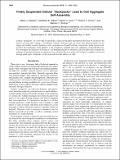Freely Suspended Cellular “Backpacks” Lead to Cell Aggregate Self-Assembly
Author(s)
Irvine, Darrell J.; Cohen, Robert E.; Rubner, Michael F.; Gilbert, Jonathan Brian; Swiston, Albert J., Jr.
DownloadSwiston-2010-Freely Suspended Cellular “Backpacks”.pdf (3.673Mb)
PUBLISHER_POLICY
Publisher Policy
Article is made available in accordance with the publisher's policy and may be subject to US copyright law. Please refer to the publisher's site for terms of use.
Terms of use
Metadata
Show full item recordAbstract
Cellular “backpacks” are a new type of anisotropic, nanoscale thickness microparticle that may be attached to the surface of living cells creating a “bio-hybrid” material. Previous work has shown that these backpacks do not impair cell viability or native functions such as migration in a B and T cell line, respectively. In the current work, we show that backpacks, when added to a cell suspension, assemble cells into aggregates of reproducible size. We investigate the efficiency of backpack−cell binding using flow cytometry and laser diffraction, examine the influence of backpack diameter on aggregate size, and show that even when cell−backpack complexes are forced through small pores, backpacks are not removed from the surfaces of cells.
Date issued
2010-06Department
MIT Materials Research Laboratory; Lincoln Laboratory; Massachusetts Institute of Technology. Department of Biological Engineering; Massachusetts Institute of Technology. Department of Chemical Engineering; Massachusetts Institute of Technology. Department of Materials Science and EngineeringJournal
Biomacromolecules
Publisher
American Chemical Society (ACS)
Citation
Swiston, Albert J. et al. “Freely Suspended Cellular ‘Backpacks’ Lead to Cell Aggregate Self-Assembly.” Biomacromolecules 11.7 (2010): 1826–1832. © 2010 American Chemical Society
Version: Final published version
ISSN
1525-7797
1526-4602